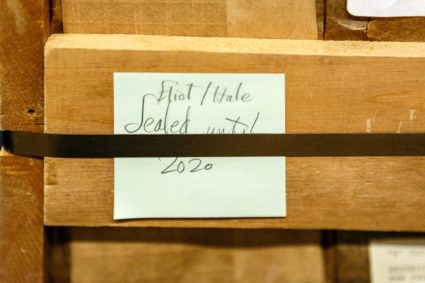
T.S. Eliot letters to his muse to be unveiled after 60 years
After more than 60 years spent sealed up in a library storage facility, about 1,000 letters written by poet T.S. Eliot to confidante Emily Hale will be unveiled this week, and scholars hope they will reveal the extent of a relationship that's been speculated about for decades.
Many consider Hale to not only be his close friend, but also his muse, and they hope their correspondence will offer insight into the more intimate details about Eliot's life and work. Students, researchers and scholars can read the letters at Princeton University Library starting Thursday.
"I think it's perhaps the literary event of the decade," says Anthony Cuda, an Eliot scholar and director of the T.S. Eliot International Summer School. "I don't know of anything more awaited or significant. It's momentous to have these letters coming out."
Lifelong friends, Hale and Eliot exchanged letters for about 25 years beginning in 1930. The two met in 1912 in Cambridge, Massachusetts, but did not rekindle their friendship until 1927. Eliot was already living in England and Hale taught drama at U.S. universities, including Scripps College in California.
In 1956, Hale donated the letters under an agreement they wouldn't be opened until 50 years after either her or Eliot's death, whichever came second. Eliot died in 1965. Hale died four years later.
Biographers say Eliot ordered Hale's letters to him to be burned.
Their relationship "must have been incredibly important and their correspondence must have been remarkably intimate for him to be so concerned about the publication," Cuda says.

T.S. Eliot was born in St. Louis, Missouri, in 1888 and gained notoriety as a poet early in life. He was only 26 when "The Love Song of J. Alfred Prufrock" became his first professionally published poem.
His best known works include "The Waste Land," "The Hollow Men" and "Four Quartets."
The first poem in the "Quartets" series, called "Burnt Norton," piques the interest of enthusiasts of the poet, says Eliot scholar Frances Dickey, because of lines that suggest missed opportunities and what might have been with his muse. The poem is named after a home in England that Eliot visited with Hale in 1934.
"His relationship with her seems to be deep and meaningful and it's a door he chose not to open," she said.
The letters could also reveal details about Eliot's conversion to Anglicanism, something he deeply cherished, Dickey says.
Dickey, who served as one of the editors on "The Complete Prose of T.S. Eliot", said the poet was deeply ashamed of his marriage to his first wife, Vivienne Haigh-Wood, whom he was with for more than 15 years. Dickey said the letters could reveal just how close he and Hale were and if the two ever considered marriage.
"Was this an epistolary romance they would carry across the Atlantic?" Dickey said. "What role did she play in his emotional life?"
Eliot's letters to Hale began after that first marriage ended. Whatever else she was, Hale was a link to the life Eliot had left behind in the United States as a young man, Dickey said.
"He was really thinking more about the United States and his childhood during the period where he was in correspondence with Hale," says Dickey. "I have a feeling that having a relationship with an American woman helped him to uncover his past in a way."

The unsealed boxes, which also contain photographs, clippings and other ephemera, were actually opened at the library's special collections area called Firestone Library in October for cataloging and digitizing. Daniel Linke, interim head of special collections at the library, was part of the team working on the 14 boxes. He said there was very minimal, if any, reading.
He said that scholars from around the world will be traveling to Princeton in the first days they are available since they are copyrighted and won't be made available online.
"It will be the special collections equivalent of a stampede at a rock concert," Linke said.
Support Canvas
Sustain our coverage of culture, arts and literature.


















